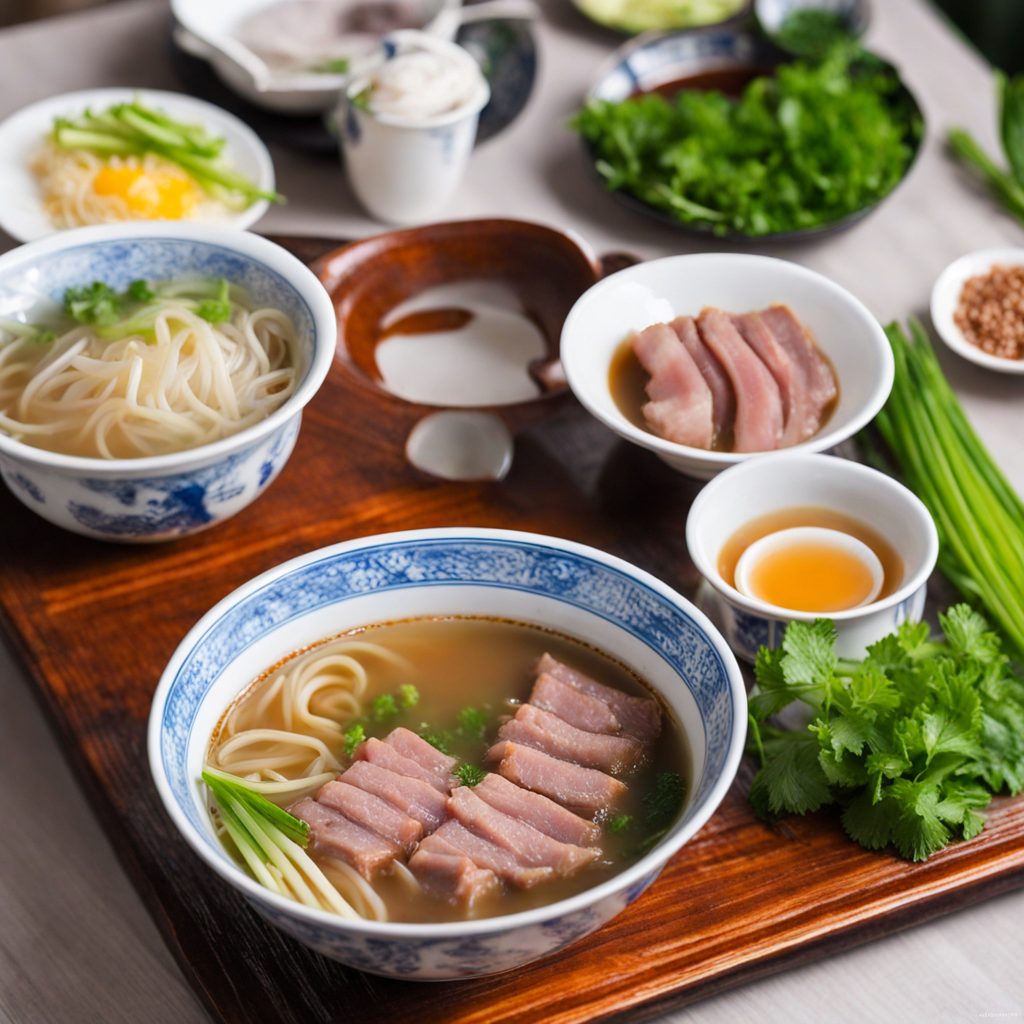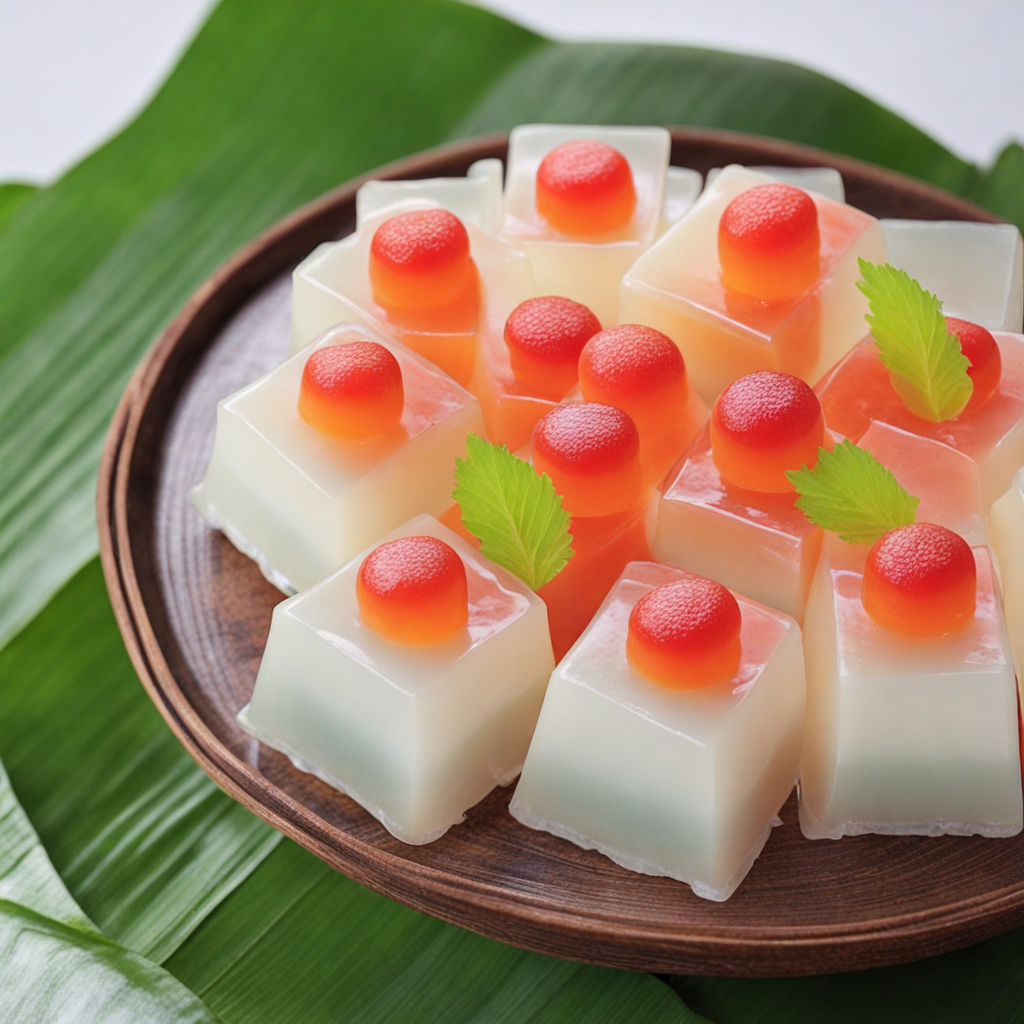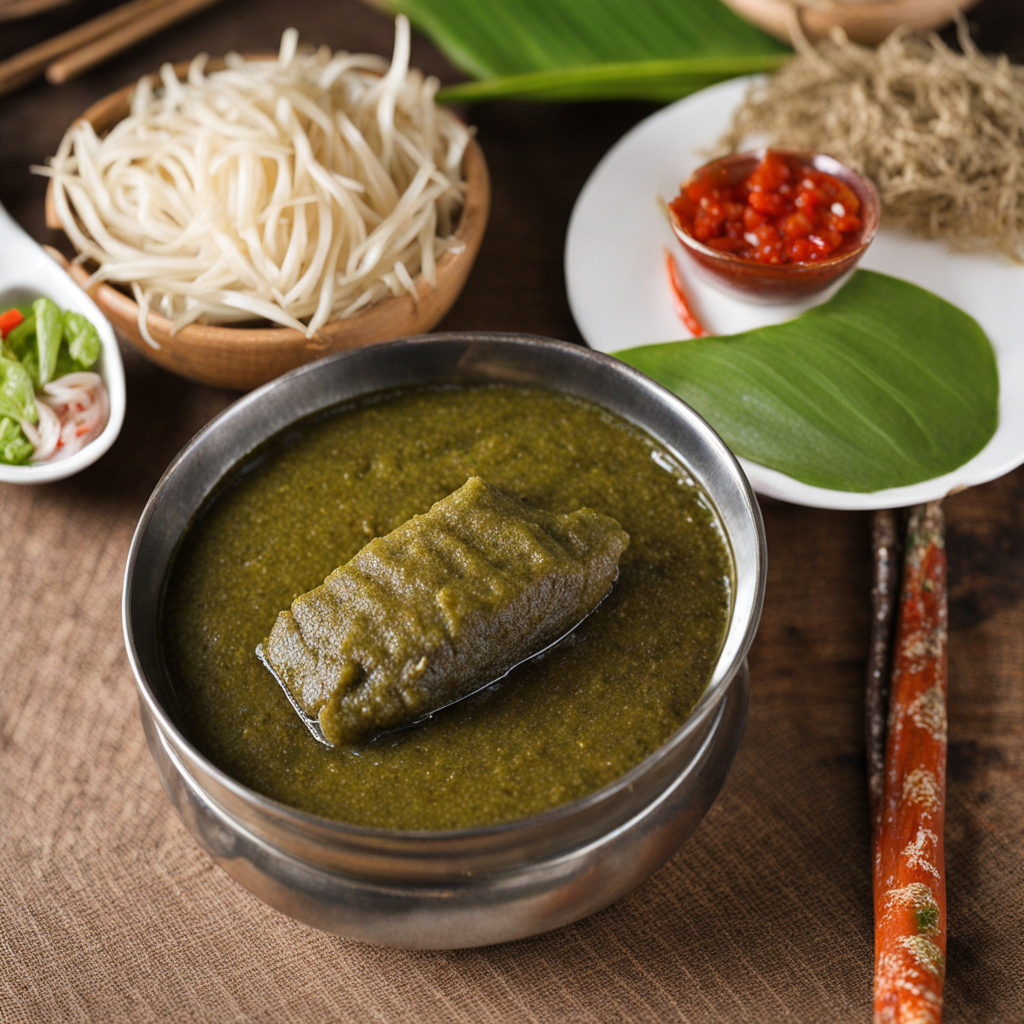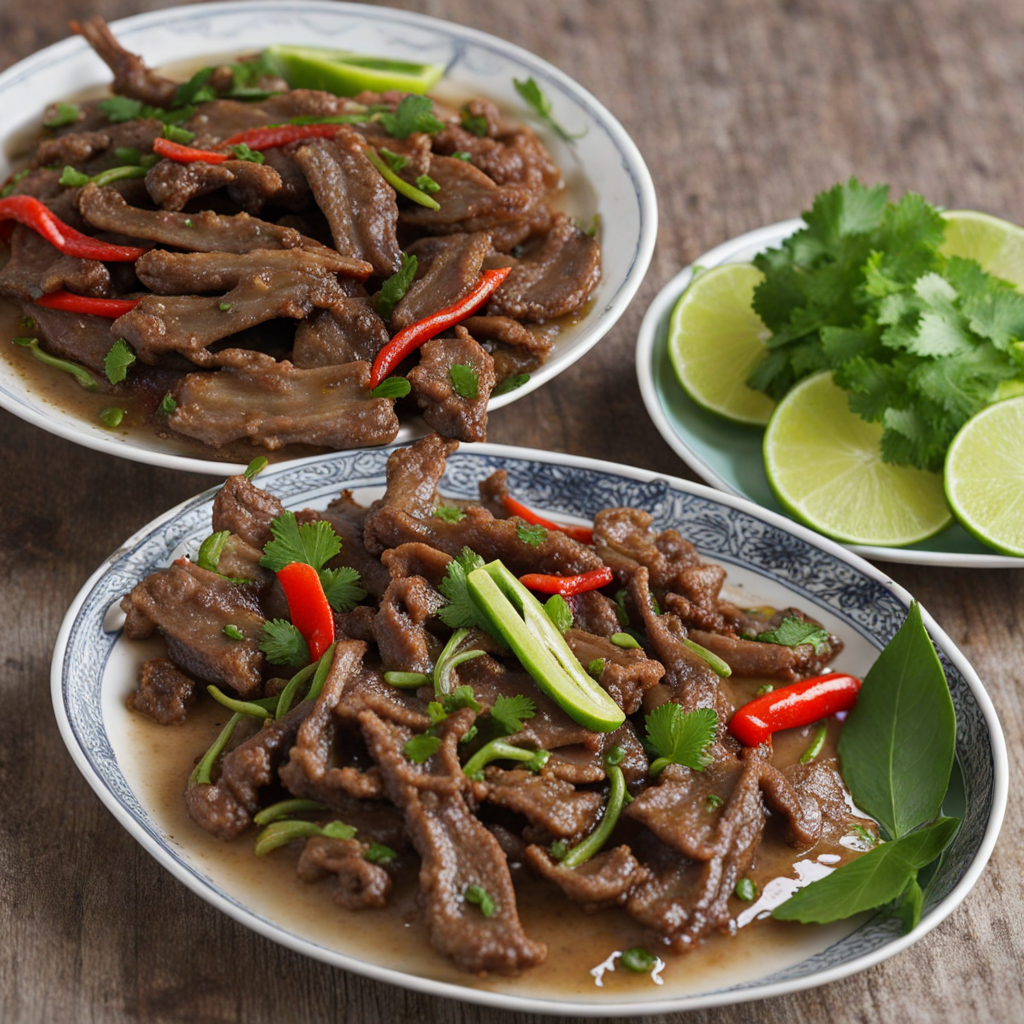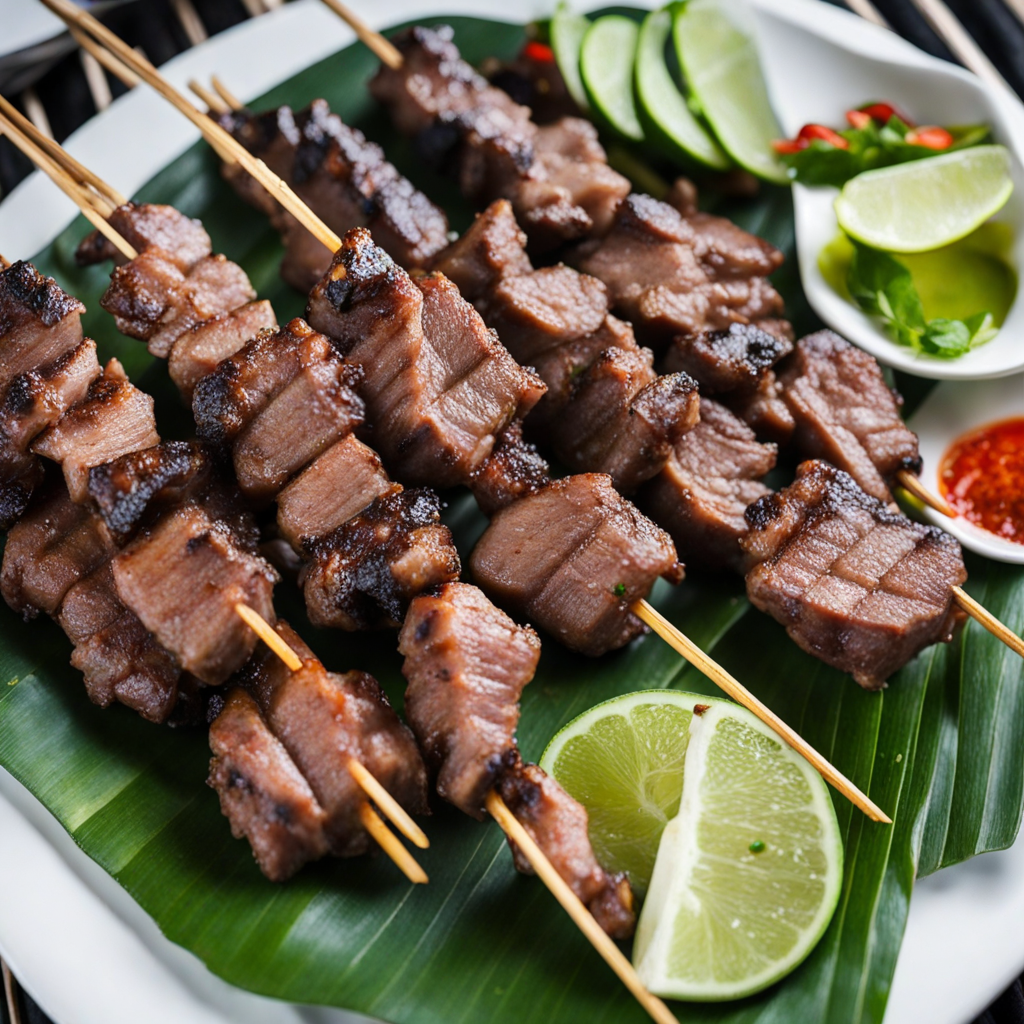Kuy Teav
Kuy Teav is a beloved Cambodian noodle soup that offers a delightful combination of flavors and textures, making it a must-try for any food enthusiast. At its core, Kuy Teav features rice noodles that are soft yet chewy, served in a fragrant broth that is typically made from pork or beef bones, simmered to perfection to extract a deep, savory taste. The broth is often infused with hints of garlic, shallots, and a touch of lime, delivering a refreshing and aromatic experience with each spoonful. What sets Kuy Teav apart is its vibrant array of toppings and accompaniments. Diners can customize their bowl with a variety of ingredients such as tender slices of beef, succulent pork, or fresh seafood. Additionally, fresh herbs like cilantro, basil, and mint are commonly added, along with bean sprouts, scallions, and a squeeze of lime for brightness. A drizzle of chili sauce or a sprinkle of fried shallots further elevates the flavors, creating a beautiful balance of heat, acidity, and richness that is truly satisfying. Kuy Teav is not just a dish; it is a social experience often enjoyed at breakfast or throughout the day in bustling street stalls and local eateries. Its comforting essence and the ability to cater to individual preferences make it a staple in Cambodian cuisine. Each bowl tells a story, bringing together the warmth of home-cooked flavors and the lively spirit of community dining, inviting you to explore the rich culinary heritage of Cambodia with every delicious bite.
How It Became This Dish
The History of Kuy Teav: A Culinary Journey through Cambodia Origins and Ingredients Kuy Teav, a beloved noodle soup from Cambodia, is a dish steeped in rich history and cultural significance. Its roots can be traced back to the early days of the Khmer Empire, which flourished from the 9th to the 15th centuries. The empire was known for its impressive architecture, advanced irrigation systems, and vibrant trade networks that connected it to regions as far away as China and India. These interactions greatly influenced Cambodian cuisine, with ingredients and cooking techniques flowing in from neighboring countries. The name "Kuy Teav" itself is derived from the Khmer language, where "kuy" means noodles, and "teav" refers to the broth. The primary ingredient of Kuy Teav is rice noodles, which are made from finely ground rice flour and water, creating thin, translucent strands. This simple yet versatile base allows for an array of toppings and flavorings, making each bowl of Kuy Teav a unique experience. In its earliest form, Kuy Teav was likely a humble dish prepared by local farmers and workers, utilizing available ingredients such as herbs, spices, and meat. Over the centuries, it evolved, absorbing influences from various cultures, particularly the Chinese, Vietnamese, and Thai. This melding of culinary traditions contributed to the diverse flavors and textures that characterize modern Kuy Teav. Cultural Significance Kuy Teav holds a special place in Cambodian culture, serving as a symbol of community and comfort. It is often enjoyed as a breakfast dish, with bustling street vendors selling steaming bowls from early morning until late afternoon. The act of gathering around a bowl of Kuy Teav fosters a sense of togetherness, as friends and families share stories and laughter over their meals. The dish is also a staple during celebrations and special occasions. In Cambodian society, food is an essential part of life, often reflecting the values and beliefs of the people. Kuy Teav's adaptability allows it to be customized for various events, from simple family gatherings to grand festivals. During the Khmer New Year, for instance, families may prepare elaborate versions of Kuy Teav, incorporating unique ingredients to symbolize prosperity and good fortune. Moreover, Kuy Teav serves as a canvas for culinary expression among chefs and home cooks alike. Each region of Cambodia boasts its own variations of the dish, showcasing local ingredients and flavors. In Phnom Penh, for example, you might find versions topped with beef or pork, while in Siem Reap, seafood may take center stage. This regional diversity not only highlights the richness of Cambodian cuisine but also fosters a sense of identity and pride among its people. Development Over Time While Kuy Teav has ancient origins, its development over time has been marked by historical events, social changes, and globalization. The Khmer Rouge regime (1975-1979) had a profound impact on Cambodian society and its culinary traditions. During this dark period, many Cambodians faced severe food shortages, leading to a loss of culinary heritage as families were displaced and traditional cooking practices disrupted. However, the resilience of the Cambodian people ensured that the essence of dishes like Kuy Teav endured. In the years following the Khmer Rouge, as Cambodia began to rebuild, Kuy Teav re-emerged as a symbol of resilience and hope. Street vendors, many of whom were women, played a crucial role in revitalizing the culinary landscape. They set up makeshift stalls, serving affordable and delicious bowls of Kuy Teav to the masses. This grassroots movement not only provided sustenance but also fostered a sense of normalcy and community in a recovering nation. As Cambodia opened up to the world in the 1990s, Kuy Teav began to gain international attention. Tourists flocked to the country, eager to experience its rich culture and cuisine. Restaurants began to offer upscale versions of the dish, often incorporating gourmet ingredients and modern presentation techniques. This evolution allowed Kuy Teav to transcend its humble origins while still honoring its traditional roots. In recent years, the rise of food tourism and the global interest in Southeast Asian cuisine have propelled Kuy Teav into the spotlight. Chefs and food enthusiasts around the world have embraced the dish, experimenting with flavors and techniques. Social media has played a pivotal role in this phenomenon, with vibrant images of Kuy Teav capturing the attention of food lovers everywhere. Regional Variations and Modern Interpretations Today, Kuy Teav is celebrated for its versatility and adaptability. While the traditional broth is often made from pork bones or beef, contemporary interpretations have seen the inclusion of chicken, seafood, and even vegetarian options. The use of fresh herbs, lime, and chili adds layers of flavor, allowing diners to customize their bowls to suit their preferences. Regional variations further enrich the Kuy Teav experience. In the coastal areas, seafood versions featuring shrimp, squid, or fish are popular, reflecting the abundance of fresh catch. In urban centers like Phnom Penh, you might encounter Kuy Teav topped with a mix of meats, herbs, and fried shallots, creating a symphony of flavors in each bite. The growth of food markets and culinary festivals has also contributed to the popularity of Kuy Teav. These events celebrate the dish and its cultural significance, allowing vendors and chefs to showcase their interpretations while educating attendees about its history and importance. Conclusion Kuy Teav, with its humble origins and deep cultural significance, is more than just a noodle soup; it is a testament to the resilience of the Cambodian people and their culinary heritage. This dish, which has evolved over centuries, mirrors the journey of a nation that has faced adversity yet continues to celebrate its rich traditions. As Kuy Teav garners international acclaim, it serves as a bridge between cultures, inviting people from all walks of life to experience the flavors of Cambodia. Whether enjoyed at a street stall in Phnom Penh or in a fine dining establishment, each bowl of Kuy Teav tells a story—a story of history, community, and the enduring power of food to bring people together.
You may like
Discover local flavors from Cambodia



